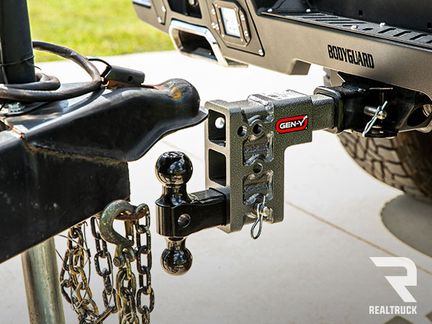Free Shipping on Orders Over $100
How to Determine Your Truck’s Towing Capacity
Updated on May 5, 2025
Towing capacity—it’s a term we’ve all heard, a value we've all compared when purchasing a new truck, and a factor we've all considered, but what metric does this term actually refer to? Not to mention, how does one determine the towing capacity of their particular truck?
These are crucial concepts to grasp if you plan to tow with your truck. Fortunately, the experts at RealTruck are here to shed some light. In this RealSource feature, we answer all your questions about towing capacity to ensure safe, reliable, and effective performance.
What is Towing Capacity?
So, what is towing capacity anyway? While the term seems self-explanatory, you'll need to consider a couple of hidden variables.
In simplest terms, a vehicle’s towing capacity refers to the maximum weight said vehicle can safely and reliably pull, according to manufacturer guidelines. This value accounts for several factors, including your vehicle’s powertrain, drivetrain, suspension configuration, bed/cab configuration, and more.
Now, when considering towing capacity, you can’t just account for the weight of an empty trailer. You’ll also need to consider the weight of fuel, water, and any other cargo that can considerably increase a trailer’s weight. For example, while a camper with a 10,000-lb. dry weight may fit within your truck’s 10,500-lb. towing capacity, filling up its 100-gallon water tank can easily add nearly 850 pounds, thus rendering your truck overloaded.
Why is Following Your Vehicle’s Towing Capacity Important?
Manufacturers assign towing capacities to vehicles to ensure the reliability of mechanical parts, the safety of drivers and passengers, and the safety of other drivers on the road. Drastically overloading a vehicle can lead to mechanical failure or accident/injury from overloading mechanical components.
For example, while a truck may be able to physically move more weight than it’s rated to tow, its brakes aren't rated to stop said weight. During a fast maneuver or quick stop, this overloading can lead to overheated brakes, longer stopping distances, and, thus, the inability to avoid a collision.
Towing Terminology
Before we determine your vehicle’s towing capacity, let’s first define some commonly encountered terms when reading labels and discussing towing capacities.
Gross Vehicle Weight Rating (GVWR)
GVWR refers to the maximum amount a vehicle can safely weigh, including passengers and cargo.
Gross Combined Weight Rating (GCWR)
This term is similar to GVWR, accounting for the maximum amount a vehicle can safely weigh, including passengers and cargo. However, it also incorporates a vehicle’s towing capacity into this value. Essentially, a vehicle’s GCWR equals its GVWR plus its towing capacity.
Gross Axle Weight (GAW)
A vehicle’s GAW refers to the amount of weight its axles can support independently. The rear number is typically higher than the front since the rear will bear the brunt of payload and towing duties.
Curb Weight
Curb Weight is a measurement of a vehicle's weight in its “ready-to-use” state, including fluids. This value does not include passengers, payload, or towing weight.
Tongue Weight
Tongue weight is an essential term when towing. This value refers to the amount of weight that the coupling between the truck and trailer can support.
Determining Your Vehicle’s Towing Capacity
Determining your vehicle’s towing capacity is easy so long as you know where to look. In this section, we’ll cover the places where you’re likely to find your vehicle’s towing capacity posted.
Check the Owner’s Manual
Aside from a quick Google search, the quickest and easiest place to find any technical information is to look through your vehicle’s owner’s manual. This informational booklet should outline this value directly. If you don’t have access to the factory owner’s annual, continue to one of the next locations.
Check the Door Sticker/Glove Box
While these locations typically won’t print the exact towing capacity in pounds, they’ll include the two values required to calculate towing capacity on your own. For this calculation, we’ll need to locate the vehicle’s GCWR (Gross Combined Weight Rating) and curb weight. To calculate your vehicle’s towing capacity, subtract the curb weight from the GCWR. The resulting value is the maximum weight your vehicle can safely carry, including a trailer, cargo, passengers, pets, etc.
Verify Trailer Weight
With your vehicle’s towing capacity calculated, you’ll need to verify that the trailer falls within the safety margin. To determine your trailer’s weight, locate the VIN sticker on the front half of the frame. This sticker contains all essential weight information, including the GVWR, empty weight, and max capacity (MAX GVCC). So long as these values fall below your vehicle’s towing capacity, the trailer is safe to tow.
Verify Supporting Accessories
Lastly, we’ll need to verify that your truck is outfitted with the proper towing equipment to tow your trailer. Consider the hitch class (weight rating) and the presence of a trailer brake controller (required with loads over 3,000 lbs.)
For more information on trailer hitch classes, check out the table below:
Class | Gross Trailer Weight (GTW) | Tongue Weight (TW) | Hitch Ball Size |
Class I | 1,000–2,000 lbs. | 100–200 lbs. | 1-¼” |
Class II | 2,000–3,500 lbs. | 200–350 lbs. | 1-¼” |
Class III | 3,500–8,000 lbs. | 350–800 lbs. | 2” |
Class IV | 5,000–12,000 lbs. | 500–1,200 lbs. | 2” |
Class V | 10,000–25,000 lbs. | 1,000–4,000 lbs. | 2”, 2-½”, 3” |
Tow Like a Pro: RealTruck Resources
At RealTruck, we’re more than just a retailer—we’re your one-stop shop for parts, assistance, and education. For more information on setting up your truck to tow, check out our towing resources.
Shop Now
RealTruck is your home for the best products to outfit your build for unforgettable adventures.
Towing Suspension | Leveling Kits | All Towing Equipment | Hitches | Hitch Balls
See Recent RealSource Articles Here...
- …
Join over 2 million RealTruck people
Get exclusive savings, insider information, and the latest RealTruck articles sent straight to your inbox.











